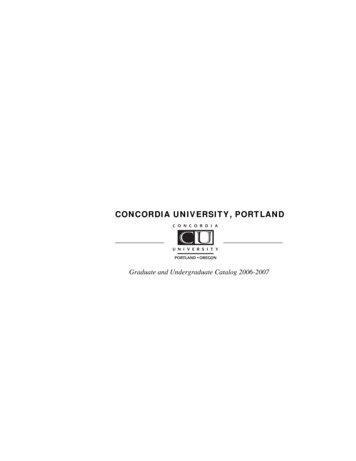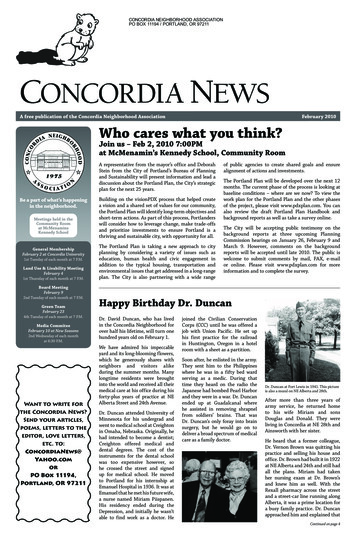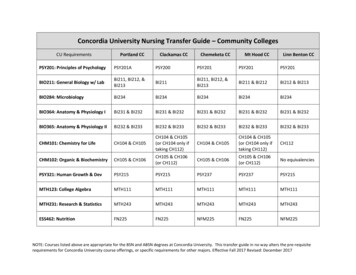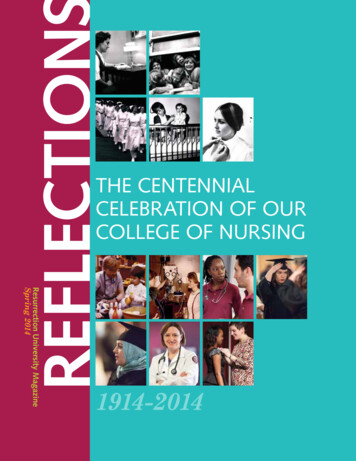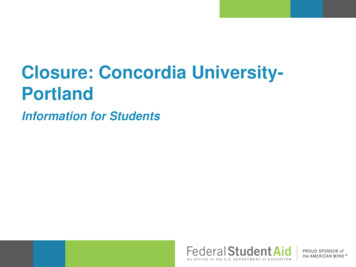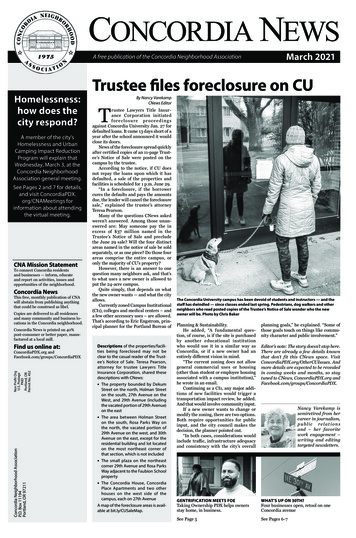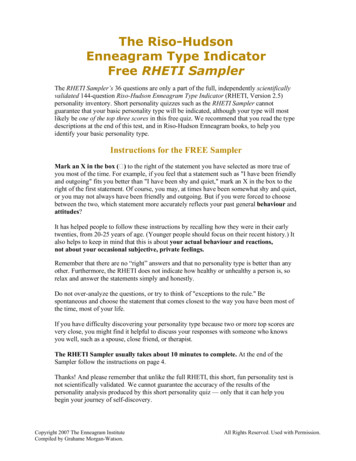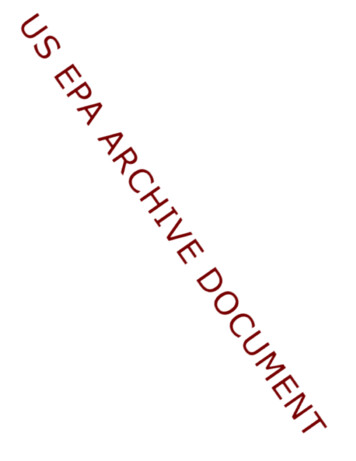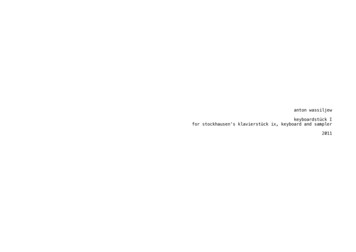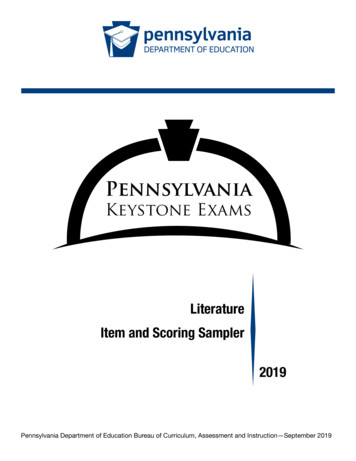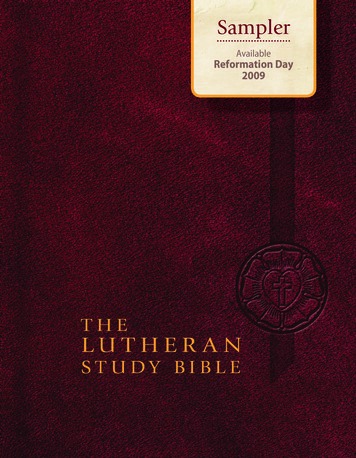
Transcription
SamplerAvailableReformation Day2009
THELUTHERANSTUDY BIBLEEngage in devotional, Christ-centered reading and studywith the comprehensive notes and practical applicationof The Lutheran Study Bible.This new Bible is the first in English to be developed from the ground up,with notes that are distinctively Lutheran, prepared by Lutheran contributorsfrom over twenty church bodies. Current scholarship, insights from the ChurchFathers, and rich devotional commentary provide meaningful perspectivefor both young and mature Christians.Discover more at cph.org/lutheranbible V iew additional excerpts Learn more about The Lutheran Study Bible A ccess podcasts featuring project contributors discussingthe significance of The Lutheran Study Bible S hare the news with your congregation using free downloadablebulletin inserts and presentation slides O rder your copy of The Lutheran Study Bible
English Standard VersionGeneral EditorEdward A. EngelbrechtAssociate EditorsPaul E. DeterdingScott R. MurrayRoland Cap EhlkeDaniel E. PaavolaJerald C. JoerszVictor H. PrangeMark W. LoveRobert A. SorensenSteven P. MuellerMichael P. WaltherWhoever believes and holds to Christ’s Word, heaven stands opento him, hell is shut, the devil is imprisoned, sins are forgiven, andhe is a child of eternal life. That is what this book teaches you—the Holy Scripture—and no other book on earth.—Martin Luther
Copyright 2009 Concordia Publishing House3558 S. Jefferson Ave., St. Louis, MO 63118-39681-800-325-3040 www.cph.orgAll rights reserved. Except as noted below, no part of this publication may be reproduced, stored in a retrieval system, ortransmitted, in any form or by any means, electronic, mechanical, photocopying, recording, or otherwise, without the priorwritten permission of Concordia Publishing House.This publication contains The Holy Bible, English StandardVersion . Copyright 2001 by Crossway Bibles, a publishingministry of Good News Publishers, Wheaton, Illinois. The ESVtext appearing in this publication is reproduced and publishedin cooperation between Good News Publishers and ConcordiaPublishing House and by permission of Good News Publishers.Unauthorized reproduction of this publication is prohibited.The ESV text may be quoted (in written, visual, or electronicform) up to and inclusive of one thousand (1,000) verses without express written permission of the publisher, providing thatthe verses quoted do not amount to a complete book of theBible nor do the verses quoted account for 50 percent or moreof the total text of the work in which they are quoted.The ESV may be quoted for audio use (audio cassettes, CDs,audio television) up to two hundred fifty (250) verses withoutexpress written permission of the publisher, providing that theverses quoted do not amount to a complete book of the Biblenor do the verses quoted account for 50 percent or more of thetotal text of the work in which they are quoted.Notice of the copyright must appear as follows on the titlepage or copyright page of printed works quoting from theESV, or in a corresponding location when the ESV is quoted inother media:“Scripture quotations are from the Holy Bible, EnglishStandard Version , copyright 2001 by CrosswayBibles, a publishing ministry of Good News Publishers. Used by permission. All rights reserved.”When more than one translation is quoted in printed worksor another media, the foregoing notice of copyright shouldbegin as follows:Permission requests that exceed the above guidelinesmust be directed to Good News Publishers, Attn.: BibleRights, 1300 Crescent Street, Wheaton, IL 60187, USA orpermissions@crossway.org.Permission requests for use within the UK and EU that exceedthe above guidelines must be directed to HarperCollins Religious, 77–85 Fulham Palace Road, Hammersmith, LondonW68JB, England.The Holy Bible, English Standard Version (ESV) is adapted fromthe Revised Standard Version of the Bible, copyright Division ofChristian Education of the National Council of the Churches ofChrist in the U.S.A. All rights reserved.Several articles were adapted from LifeLight TM and LifeLightFoundations, 1990– Concordia Publishing House.The quotations from the Lutheran Confessions are from Concordia: The Lutheran Confessions, second edition; edited byPaul McCain, et al., copyright 2006 Concordia PublishingHouse. All rights reserved. Brackets from Concordia.Catechism quotations are taken from Luther’s Small Catechismwith Explanation, copyright 1986, 1991 Concordia PublishingHouse. All rights reserved.Some notes for Nu, 1Ki, 2Ki, 1Ch, 2Ch, Is, Jer, and Lm wereadapted from The Concordia Self-Study Commentary, 1971,1979 Concordia Publishing House.Quotations marked AE are from vols. 1, 2, 3, 4, 5, 6, 7, 8, 9, 10,11, 12, 13, 14, 15, 16, 17, 18, 19, 20, 21, 22, 23, 24, 25, 26, 27, 28,29, 30 of Luther’s Works, American Edition Concordia Publishing House. All rights reserved.“ Unless otherwise indicated, all Scripture quotationsare from . . . [etc.]”, or,Quotations marked AE are from vols. 31, 33, 34, 35, 36, 37, 38,39, 40, 41, 42, 43, 44, 45, 46, 47, 50, 51, 52, 53, 54 of Luther’sWorks, American Edition Muhlenberg and Fortress Press,used by permission of Augsburg Fortress Publishers.“ Scripture quotations marked (ESV) are from . . .[etc.].”Color portrait of Jesus 2004 CPH/Douglas Fryer/Scott HullAssociatesThe “ESV” and “English Standard Version” are trademarks ofGood News Publishers. Use of either trademark requires thepermission of Good News Publishers.When quotations from the ESV text are used in non-saleablemedia, such as church bulletins, orders of service, posters,transparencies, or similar media, a complete copyright noticeis not required but the initials (ESV) must appear at the endof a quotation.2Publication of any commentary or other biblical referencework produced for commercial sale that uses the English Standard Version must include written permission for the use ofthe ESV text.cph.org/lutheranbibleManufactured in the United States of America1 2 3 4 5 6 7 8 9 1018 17 16 15 14 13 12 11 10 09
ContentsComparison Chart4–5The Story of The Lutheran Study Bible6–9Features of The Lutheran Study Bible10–13The Books of Romans41–46Contributors47–48See page 20 forLarger PrintSampleBe sure to visit www.cph.org/lutheranbible for additionalsamples, other information, and order and pricing information.Note: This sampler is not a final edition of The Lutheran Study Bible. For instance,pagination and cross-reference page numbers were not finalized at this printing.cph.org/lutheranbible3
FeaturescomparedPublishersand TheologyScripture VersionScripture ColumnsApocrypha IncludedIntro to Each Bible BookMaps/References to MapsConcordance EntriesStudy NotesPresentation/Family Records PagesCharts, DiagramsChronology/TimelinesCross-reference System EntriesGospel Harmony ReferencesMaps IndexOutlines of Bible BooksIndexing or Chain Reference SystemDiscussion QuestionsWords of Christ in RedIcons Identifying Features of NotesBiblical Book OverviewTransliteration SystemWeights and MeasuresThematic ArticlesExplanations of Hebrew/Greek WordsNIV StudyBibleLifeApplicationStudy BibleConcordia PublishingHouse; LutheranZondervan;EvangelicalTyndale; EvangelicalESV2NIV2NIV1 36 Maps; 880 refs31,000 26,500 62 Maps35,000 20,000 200 Maps 12040260 90,000 100,000 220 Reading Plan/LectionariesRunning ChronologyOrder of Daily PrayerLuther’s Small CatechismCollection of PrayersInsights from Church Fathers Total Features Presented30Genre IntrosKey Terms/Phrases of DictionaryWe have more to offer.4The LutheranStudy Biblecph.org/lutheranbible c 10,000 100 2221 When compared with other popular study Bibles,The Lutheran Study Bible offers more notes, morelife applications, more articles on biblical themes,and more features overall.
ConcordiaSelf-StudyBibleNelsonStudy BibleESV StudyBibleLutheranStudy BibleThompsonChainReferenceBibleHarperCollinsStudy BibleCPH; Lutheran Ed.of NIV Study BibleThomas formedAugsburg/Fortress;Higher Critical/Liberal/LutheranVarious Publishers;MethodistHarperCollins;Higher Critical/LiberalNIV2NKJV2ESV1NRSV1NKJV2NRSV2 57 Maps35,000 c 20,00078 Maps200 Maps15 Maps 16 Maps 35 100,000 20,000 80200 Yes; No2515,000 80,000 SometimesYes 100508 Yes Yes; NoSomeSomeWhere other study Bibles stop,ours provides other tools and devotionalfeatures that help you apply and appreciatethe teachings of Scripture for your life.Some Luther18181816Our Study Bible was carefully designed to include more—in a sizethat you can easily carry to Bible class! This chart above showsat a glance the unique and rich features of our Study Bible.1111cph.org/lutheranbible5
The Story ofThe Lu ther a n St udy BibleThe story begins in 1521 in anisolated room at Wartburg Castle,a mountaintop fortress in Eisenach, Germany. Martin Luther had been taken there under protectivecustody by Elector Frederick the Wise after beingdeclared to be not just a heretic but an outlaw byCharles V, the Holy Roman Emperor. Frederick gaveLuther safe haven and protection to prevent hisarrest and execution, both very real threats anddangers imposed on Luther as a result of his boldconfession of Christ and His Word. Consequently,Luther had nothing but time on his hands, and heput that time to very good use.Among other projects during his exile at the Wartburg, Luther translated the New Testament intoGerman, which was published in September 1522after his return to Wittenberg from the Wartburg inMarch 1522. Luther’s work of translating the Biblecontinued until the end of his life. He and a team ofcolleagues continued working on the translation ofthe Bible, including the entire Old Testament, andin 1534, the first complete “Luther Bible” was published. It was repeatedly updated in new editionsuntil Luther’s death in 1546.6cph.org/lutheranbibleAlready in the first complete edition of the LutherBible, we see the beginnings of a great traditionin the Lutheran Church: providing an annotatededition of the Bible, with helps and notes for thereader. Why? In Acts 8, we read about an Ethiopiancourt official who was reading from the Bible, andwhen the Holy Spirit sent Philip to him, the Ethiopian asked Philip, “How can I understand this, unless someone guides me?” (v. 31). It is the desire toexplain the meaning of the Bible that is the foundation for all the various study editions of the Biblethat have been published in the Lutheran Churchsince 1534.Early Lutheran Study BiblesOne particularly famous study edition of the Biblewas an enormous two-volume work containing theentire Bible, as well as Luther’s notes and observations on every book of the Bible. This edition wasprepared by the great orthodox Lutheran theologian Abraham Calov, and it is this Bible that wasowned by J. S. Bach, the famous Lutheran churchmusician, who read and studied it carefully. Theso-called “Bach Bible,” complete with Bach’s signature on the title page, is now part of the rare
book collection at Concordia Seminary, St. Louis.Another large and very popular study Bible projectwas the Weimar Bible, which was begun by JohannGerhard but completed in the later 1600s after hisdeath. This Bible contained application notes forthe reader.Dr. C. F. W. Walther, the first president of The Lutheran Church—Missouri Synod, was particularlyproud of the fact that the Missouri Synod was instrumental in the publication of an American edition, produced by the American Lutheran BibleSociety that Walther and others had founded andwhose rights and properties were eventuallyturned over to the Missouri Synod. The AltenburgBible is a massive multi-volume work containing foreach chapter of every book of the Bible devotionalthoughts based primarily on the writings of MartinLuther and also a prayer. It is the most comprehensive study and devotional edition of the Bible everproduced in the Lutheran Church.The German Lutheran study Bible tradition in theMissouri Synod continued into the early twentiethcentury, with each Bible containing Lutheran notesand studies. Concordia Publishing House sold morerecent printings of the Weimar Bible and kept theAltenburg Bible in print as well. This tradition cameto an end somewhat abruptly in the first few decades of the twentieth century when the MissouriSynod moved from being primarily a Germanspeaking church to an English-speaking church. Interestingly, also at this time the apocryphal booksthat had been in every edition of the Bible since thetime of Luther no longer appeared in English editions of the Bible published by Concordia Publishing House.English Study Bibles fromConcordia Publishing HouseThe first study Bible in English published for Lutherans by Concordia Publishing House was a Biblewith study notes borrowed from an edition of theKing James Version by the American Bible Society.The notes were reviewed and edited by a profes-sor from Concordia Seminary. Other English studyBibles came along, and in most cases they werenot based on Lutheran editions of the Bible but onconservative Reformed or generically conservativeProtestant Bibles. One exception was the publication of the Concordia Bible with notes, publishedby Collins for Concordia Publishing House in 1952,with a second edition published in 1971; however,this Bible was only the New Testament, with Lutheran notes prepared by Dr. Martin Franzmann ofConcordia Seminary, St. Louis.The most recent study Bible published by Concordia Publishing House is the Concordia Self-Study Bible. This project involved a general editor and threeassociate editors who worked through the notescontained in the New International Version Study Bible, a conservative Reformed/Evangelical edition ofthe Scriptures published by Zondervan (historicallya conservative Dutch-Reformed publishing company, but which in recent years was acquired by theHarperCollins publishing company, itself a subsidiary of the Rupert Murdoch media conglomerate).For reasons of both expediency and finances, it wasdetermined that this would be the most efficientway to provide a study Bible for Lutherans usingthe New International Version translation.The modifications to the Reformed/Evangelicalnotes in the NIV Study Bible offered Lutheran insights, as noted in the text with a little cross symbol where there had been a change or addition tothe Reformed notes. Introductions for the variousbooks of the Bible were modified to include portions of Luther’s Bible introductions. The ConcordiaSelf-Study Bible has been in print since 1986 and hasserved the Lutheran Church well.The English Bibles with notes that were producedand offered by Concordia Publishing House allwere carefully reviewed and approved by Lutherantheologians but were primarily making use of nonLutheran notes, with additional content and modifications supplied by Lutheran theologians. Thereremained a longing for an English study Bible, prepared with exclusively Lutheran notes, commentary, and supplemental content, drawing upon thecph.org/lutheranbible7
vast, rich heritage of Lutheran biblical study andreflecting throughout the unique Christ-centered,Law/Gospel, devotional, and comprehensive nature of the previous Lutheran study Bibles knownand used since Reformation times. This longing isthe foundation for the beginning of work on TheLutheran Study Bible.Adopting theEnglish Standard VersionIn the early 1990s, The Lutheran Church—MissouriSynod began working on a new hymnal, LutheranService Book, and as was the case with the publication of previous hymnals, a decision had to be madeabout which translation of the Bible would be mostappropriate. After years of careful study and evaluation of Bible translations available, in consultationwith theologians and Bible scholars at both Missouri Synod seminaries, the Missouri Synod’s Commission on Theology and Church Relations, and themembers of the hymnal’s translation committee,the decision was made to propose to the MissouriSynod that a new translation be adopted for use inall the Synod’s worship materials: the English Standard Version (ESV).The ESV had been in development for a numberof years at the same time interest was growing inthe concept of a new hymnal for the Synod. Missouri Synod theologians were involved in the ESVtranslation project as consultants and translationadvisors. The ESV is a conservative revision of thewell-established and long-used Revised StandardVersion of the Bible, itself a descendant of the English Bible translation tradition, beginning with theKing James Version, which, ironically, was itselfheavily influenced by the previous work of WilliamTyndale. Tyndale completed his translation of theNew Testament while living in Wittenberg, Germany, in order to escape persecution from RomanCatholic officials. Tyndale borrowed heavily fromthe Luther Bible translation and sought the advice of Luther and his colleagues. Though Tyndalewas eventually executed, his translation work was8cph.org/lutheranbiblean important foundation of the great King JamesBible project.Plans for a New Study BibleAs it became increasingly clear that the ESV wouldbe the translation of choice recommended by theMissouri Synod’s Commission on Worship, Concordia Publishing House began to talk with GoodNews Publishers, the parent company of Crossway,the publisher of the ESV. A productive partnershiprelationship developed. Right around 2001, whenthe ESV was finally released, Concordia Publishing House and Good News Publishers had agreedto consider the possibility of copublishing an ESVstudy Bible.It was from that point on that the plans for The Lutheran Study Bible began to take concrete shape.Concordia Publishing House’s leadership teamrecognized that there was now a unique opportunity to produce a thoroughly Lutheran study Bible,making use of original Lutheran content, and forthe first time since the Missouri Synod had movedcompletely to English, to offer the English-speakingLutheran Church what it had enjoyed before whileusing the German language: a “from the groundup” Lutheran study Bible, making exclusive useof Lutheran notes, commentaries, articles, andannotations.The Development ofThe Lutheran Study BibleIn early 2003, work began in earnest on The Lutheran Study Bible. The first step was a large Biblereading project to glean the most common questions people have as they read the biblical text. Thisproject involved over 400 laypersons who volunteered to read assigned portions of the Bible andsubmit any questions that came to them as theyread. It was on the basis of this project that workcommenced on preparing original notes and commentary for the whole Bible.
The next stage of the project involved planningfor the enormous amount of study, research, andwriting required to produce this unique and newLutheran study Bible. A plan was set in place towork first with consultants from various Lutheranseminaries. They provided extensive research notesand explanations for every book of the Bible. Thisresearch was handed over to a team of authors,consisting primarily of active parish pastors, whowrote the study notes for the Bible. The notes wereedited by a smaller team of associate editors, withleadership and oversight for the entire editorialprocess provided by a general editor, whose supervision brought continuity and consistency to thecontent.From 2003 to 2008, planning and work on The Lutheran Study Bible was underway, with the major research, writing, copyediting, proofreading, design,and layout of the notes completed in early 2009. Bylate spring 2009, the final files will be in place andwill be sent to printers, with an anticipated deliveryof the printed Bible to Concordia Publishing Housein time for distribution by Reformation Day, October 31, 2009.An important part of the story of The Lutheran StudyBible is the external doctrinal review process. Whenthe time came to begin submitting materials tothe Missouri Synod’s doctrinal review process, CPHleadership met with the Office of the President todiscuss the unique demands of this large project.LCMS President Gerald Kieschnick appointed a special team of reviewers and assigned them the taskof reviewing The Lutheran Study Bible. Specialists inthe Old Testament and the New Testament werechosen and appointed by President Kieschnick,and by late 2008 they had completed their carefulreview work of the entire content of The LutheranStudy Bible, thus providing yet another solid layerof study, research, and thinking about The LutheranStudy Bible.In total, there have been about 600 individualsinvolved in the project through its development,research, writing, review, and final editing andpreparation. Never before in the history of English-speaking Lutheranism has there been a singlevolume edition of the Bible produced like this one,and never before has there been this large a onevolume study Bible, with this many features andunique qualities, commissioned and completed byany church body. The aim and goal throughout theproject, and what has animated and given shape toevery aspect of this Bible’s preparation, has been toprovide a resource for the lay reader that is comprehensive, devotional, and Christ centered.One of the unique insights of the Lutheran Reformation and the key to the great Gospel rediscoveryof the sixteenth century was the recognition thatthe Holy Scriptures are everywhere and alwayspoint us to the life, death, and resurrection of theSon of God, Jesus Christ, the one sent to be our perfect substitute, fulfilling all the Law’s requirementsand providing, in offering up His flesh and blood,the full forgiveness of the sins of the world. Thiswonderful Good News is the very soul and heartbeat throughout The Lutheran Study Bible as it setsforth the rich treasures of God’s Word in both Lawand Gospel, unfolding for the reader the comfort,peace, and power of God’s Word, which truly endures forever. This is the story of The Lutheran Study Bible. It is astory that began with a pastor’s desire to help people understand God’s Word and the Gospel message that permeates it throughout. May God blessall who use The Lutheran Study Bible so that they“grow in the grace and knowledge of our Lord andSavior Jesus Christ. To Him be the glory both nowand to the day of eternity. Amen” (2 Peter 3:18).Rev. Paul T. McCainPublisherConcordia Publishing Housecph.org/lutheranbible9
Features of The Lutheran Study BibleBiblical BookHeading.Appears at thetop outer marginabove the ESVtranslation.ESV BibleTranslation.Always presentedin two columnsdivided by anarrow centercolumn of crossreferences.Chapter ReferenceNumbers.Standard inBibles; firstappeared inthirteenthcentury LatinBibles.Verse ReferenceNumbers.Standard in Bibles;introduced by RobertEstienne in 1551.Actual Size10cph.org/lutheranbible
Running Chronology.Dates for a biblicalbook or for eventswithin a book. Afull chronologyof Bible history isincluded elsewhere.ESV Subheading.Summarizes largerbiblical passages forthe reader.Center Column Cross-References. Standardin reference Bibles; in Kings, Chronicles,and the Gospels, watch for specialreferences to parallel accounts. TheESV reference system is supplementedby references from the Luther Bibletradition (Das AltenburgerBibelwerk), presentedhere for the first time forEnglish readers.Cross-Reference Overflow. Appears whenthe center column cannot hold all thecross-references.ESV Translation Notes. Further clarificationof original wording or other matters.11
Features continuedTLSB Study Notes.At the bottomof each Biblepage appeartwo columnsthat explainspecific termsand phrases(italic) or provideother insightsregarding biblicalhistory, culture,literary features,and theology.Some notescontain Hebrew,Aramaic, orGreek termstransliteratedinto English. Bible texts have longappeared with notes called “glosses”; inLuther’s first Bible publication of 1522,he included such notes to aid readersof his German translation. HistoricLutheran study Bibles include DasAltenburger Bibelwerk, Das WeimarischeBibelwerk, and Calov’s Biblia Illustrata.12cph.org/lutheranbibleTLSB Law and Gospel ApplicationNotes. These notes summarizesections of Scripture, applyingboth Law and Gospel for the reader andproviding a petition or praise to guidethe reader into prayer, since studyingthe Bible is always a devotional act forLutherans.
Theology Icons.Three differenticons markweighty theologicalpassages:(1) the TrinityIcon markspassagesabout thetriune Godand Old Testamentmessianicprophecies;(2) the Word andSacrament Iconmarkspassagesabout themeans of grace;(3) the MissionIcon markspassagesaboutspreadingthe Gospel.Cross-Reference to an Article. The studynotes will often refer to introductions,articles, charts, and maps throughoutTLSB. Follow these references to gainfurther insights. A reference guide is alsoprovided elsewhere.Church Father Quotations. Numerousinsights from the Book of Concord,as well as Ancient, Medieval, andReformation-era Christian writers, areincluded to add greater depth to thenotes. A complete list of abbreviationsand works cited is provided.cph.org/lutheranbible13
3GENESIS THROUGH DEUTERONOMYThe Books of MosesACCORDING TO LONG-STANDING TRADITIONin Judaism and Christianity, the first fivebooks of Holy Scripture (Gn; Ex; Lv; Nu; Dt) areattributed to the prophet Moses. In fact, Jesusattributed these books to Moses (Mt 19:8; Mk7:10; 12:26; Jn 7:19). In Luther’s Bible translation,he titled them “the Books of Moses.”Critical Views of the Books of MosesIn the eighteenth century, scholars such asRichard Simon (1638–1712) began to wonderwhether Moses simply edited these books, wroteparts of them, or perhaps did not write them atall. A French scholar, Jean Astruc (1685–1766),noticed that in some parts of Genesis a certainHebrew word for “God” is used (Elohim), but inother parts a word for“Lord” is used (Yahweh;see p 0000). Astrucproposed that this happened because Moses used differentsources, which haddifferent namesfor God. Biblicalcritic J. G. Eichhorn (1752–1827) and other German scholars (e.g., K. H. Graf and J. Wellhausen)developed Astruc’s ideas more radically. Theirdocumentary hypothesis, or JEDP theory, assumedthat Moses did not write the books. They concluded that a much later editor drew the bookstogether from four sources: the Jahwist, Elohist,Deuteronomist, and Priestly writers. Their viewsbecame standard in liberal schools of theology andare still taught today.However, in the twentieth century, scholarssuch as J. F. H. Gunkel (1862–1932) began toquestion aspects of the JEDP theory. Others rejected it altogether. Now, in the twenty-first century, most scholars have abandoned the JEDPtheory in favor of methods that interpret largesections or entire books as whole literary compositions. Conservative biblical scholars havealways attributed these five books to Moses. Archaeology and study of the texts have affirmedthe antiquity of the books.Evidence of Sources in the BibleThe Bible itself clearly teaches that Moses usedother sources—written and oral—for composingthe first five books of Scripture. Moses’ most important source was God Himself; God dictatedportions of the books to him (cf Ex 24:3). ButMoses also mentioned or quoted the followingpotential sources:The Book of the Generations of Adam (Gn 5:1)The Saying about Nimrod (Gn 10:9)The Saying about the Mount of the LORD(Gn 22:14)The Tradition of the Sinew (Gn 32:32)The Statute of Joseph (Gn 47:26)The Song of Moses (Ex 15:1–18)The Song of Miriam (Ex 15:20–21)The Memorial for Joshua (Ex 17:14)The Book of the Covenant (Ex 24:7)The Tablets of the Testimony(Ex 24:12; 25:16)The Registration of Elders (Nu 11:26)14cph.org/lutheranbible
GENESIS THROUGH DEUTERONOMYThe Book of the Wars of the LORD (Nu 21:14–15)The Song of the Well (Nu 21:17–18)The Song of Heshbon (Nu 21:27–30)The Book of the Law (Dt 29:21; 30:10; 31:26)When giving place-names, Moses also may havedrawn on written or oral sources (cf Gn 11:9; 16:14;26:33; 33:17; 35:20; Dt 3:14). A few passages possiblyindicate later editing to provide clarity (see notes, Gn14:14; 36:31).Luther believed God’s people always passed downteachings across the generations. He wrote,Can there be any doubt that the holy fathers alwayshad their gatherings and meetings, where theyinstructed the youth, where they preached, prayed,prophesied, and praised God? The church cannotexist without the constant use of the Word. . . .Thus Abel and Cain . . . [and] Shem had meetings,sermons, forms of worship, sacrifices, and otherceremonies, which continued in existence up to thetime of Abraham. (AE 2:197)Moses did not fully explain the nature of his potentialsources or how he used them (see notes for the references above). A number of Moses’ sources are poetic,which interests historians. Since poems in Genesis “retain more archaic forms of the Hebrew language” (Hummel, p 55), this has led some scholars to conclude thatMoses created portions of Genesis by recasting earlierIsraelite poems or stories. This is possible but certainlynot proven (see p 0000; see also Luther’s comment onthe writing of Job, AE 54:79).Moses Wrote God’s WordThat Moses used other sources for writing the firstfive books of Scripture is not surprising. In fact, theevangelist Luke mentioned using sources (Lk 1:1–4),and the apostle Paul commonly quoted earlier Christianhymns and even Greek poets in his letters and sermons.The Holy Spirit blessed, guided, and directed the “research” of Moses just as surely as He guided the writersof the New Testament (see notes, Lk 1:2; 2Pt 1:21).Because the evidence for Moses’ sources is so fragmentary, scholars will no doubt continue to debate thisissue. However, faithful students of Scripture should resist the urge to discover “new sources” that Moses didnot explicitly reference, as advocates of the discreditedJEDP theory attempted to do.Literary Styles in the Book
of NIV Study Bible Thomas Nelson; Evangelical/ Reformed Crossway; Evangelical/ Reformed Augsburg/Fortress; Higher Critical/ Liberal/Lutheran Various Publishers; Methodist HarperCollins; Higher Critical/ Liberal Scripture Version ESV NIV NIV NIV NKJV ESV NRSV NKJV NRSV Scripture Columns 2 2 1 2 2 1 1 2 2 Apocrypha Included
